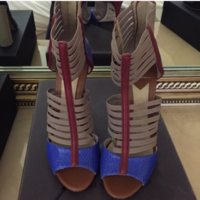I have no knowledge on the specifics of anyone's blacked out sole shoes but thought you should all know that the following applies in general to retail footwear and may be food for thought although the following is strictly my own personal opinion.
The shoes we all buy come to retailers more or less in two ways. They are either bought landed from a US agent or company who either owns or represents a specific brand or factory. That product is bought "landed" in the US at the US shoe offices of each company if they have one or bought at trade shoe shows meaning that product is delivered with all duties paid at a US wholesale price in US dollars.
The other way that footwear is bought is on a "first cost" basis directly from the factory-again either abroad at shows or at US shows. This means that the shoes are sold without any duties paid and is significantly cheaper, leaving more profit margin for the retailer but the retailer has to pay all the duties and transportation to the US. The retailer has to pay for the product upfront through a letter of credit so the retailer owns the shoes before they are even delivered.The downside of this is that since the retailer "owns" the shoes they pretty much has no leeway for any type of returns or problems unless there is really something pretty messed up about the product.
In either way, most shoe companies will not take single pair returns and that's written into the contract. Years ago, some "landed" wholesale companies would take single pair returns but some retailers would take terrible advantage of that and allow returns on product literally months and months (and longer) after delivery because of their own liberal policies which obvious benefit the retailer shoppers like us, but hurt the manufacturer as the shoes have to be written off as a loss. Retailers rarely take the loss, they always charged it back to the wholesaler if the shoes are bought landed so every time any of us thought that a retailer was "wonderful" because of their liberal return policies after we wore a shoe and decided we weren't happy with it know that the retailer didn't eat it but the wholesaler did so someone was hurt by the return.
That abuse lead to most wholesales writing "no single pair returns" into the contract which was absolutely the right thing to do. There are always exceptions to everything and I'm sure there were exceptions made for a really messed up pair (e.g. the heel falls off in the store new out of the box because it wasn't pinned properly, etc.)
So now, if you have a retailer with a liberal return policy they invariably still get numerous pairs of "worn a couple of times" shoes that they've taken back for any number of reasons. They can't (in most cases) charge them back to the wholesaler and they obviously can't put them back into their store inventory but if they have their own outlets they can be dumped there in which case they can be a great buy for the bargain shopper and realistically they can be in the same "as new" shape as any shoe on any retail floor that has been tried on numerous times before we've tried them on-the only difference is that these can't be put back into store inventory as they show wear on the sole. Even one wearing outside will show too much wear to go back into inventory.
Display shoes can end up new at "at a price" too but they're usually not thrown out of store inventory for wear on the soles-they're thrown out because there may be a significant difference in color from fade from display from the shoe in the box or if embellished, their could be some bead or whatever loss that won't match up to the 1/2 still in the box. The solution to that one is to put both shoes on display so that they age evenly but the problem with that can be theft.
Shoes can also be sent to outlets or jobbers after use on runway or print (catelogue) work but for house fashion shows the soles are usually taped and for catelogue work the shoes are usually preordered in 9's or 10's as single pairs and they can get dumped too since they are not from the actual production run.
Anyway, just trying to clarify that there are many ways that a single pair of something could show up at anyone's outlet and that wear from "display" is the least likely IMO.

 People here are just offering opinions based on their experience as customers and passion for the particular brands.
People here are just offering opinions based on their experience as customers and passion for the particular brands.







